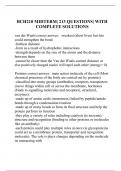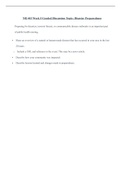Exam (elaborations)
BCH210 MIDTERM| 213 QUESTIONS| WITH COMPLETE SOLUTIONS
- Course
- BCH210
- Institution
- University Of Toronto (U Of T )
van der Waals correct answer: -weakest (short lives) but lots could strengthen the bond -furthest distance -form as a result of hydrophobic interactions -strength depends on the size of the atoms and the distance between them -cannot be closer than the Van der Waals contact distance or else po...
[Show more]





